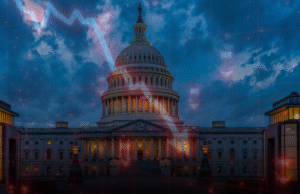
A Deadlocked Congress
The federal government stopped working at midnight because Congress couldn’t agree on money for the government. Republicans and Democrats disagree on making bigger help available for Obamacare, and neither side is willing to back down. Senators again rejected different plans to keep the government running temporarily as they went back to work on Capitol Hill, causing the first government shutdown in almost seven years.
Who’s Impacted?
Federal workers are the main ones affected when the government shuts down.
The White House says that laying off government workers is going to happen soon. Some important services are still running, like mail delivery, Social Security, and Medicare. But other services, like court cases, help for veterans, and the jobs report, have been stopped.
How Long Will It Last?
Senators are leaving for the weekend, which means the government will shut down at least until Friday, and maybe even longer. There’s no sign that the disagreement will be resolved soon as the lawmakers are not willing to give in.
The Senate Votes
The lawmakers did not agree to a short-term funding plan suggest by Republicans.
They voted 55 to 45 against it, with three Democratic senators voting with the Republicans. This plan would have kept the government management until November 21. Only one Republican, Senator Rand Paul from Kentucky, voted against it.
Earlier, all Republicans in the Senate voted against a funding plan proposed by Democrats.
The plan would have kept the government funded until the end of October and also kept the Affordable Care Act subsidies active until the end of the year, which is when they were set to expire.
House Republicans’ Bill
Last month, the House Republicans approved a bill that would fund the government until November 21. However, it needed support from Democrats to pass in the Senate, as it required 60 votes. That support didn’t happen. The Republicans also stopped a version of the bill that Democrats proposed, which included funding along with continued subsidies for the ACA and certain policy changes.
The Democratic Position
Democrats are asking for an extension of the premium tax credits for ACA health plans, which are set to end at the end of the year.
They also want to reverse some of the cuts made by Republicans to Medicaid and public media, and prevent the Trump administration from using a “pocket rescission” to lower foreign aid.
Democratic leaders say they won’t back down.
But there are some signs of disagreement within their group. Three Democratic senators voted for the Republican plan on Tuesday, which is two more than when the bill was first discussed earlier this month. Those senators said they did so because they were worried about what the Trump administration might do if the government shutdown happened.
The Trump Administration’s Approach
The administration has sought to use the shutdown to inflict political pain, deploying the departments it controls to frame Democrats as “radical.” Several federal agencies’ websites, including those of the Department of Housing and Urban Development and the U.S. Forest Service, posted partisan messages blaming Democrats for the shutdown.
Ethics Complaints Filed
In response, watchdog groups have filed complaints. Public Citizen filed a Hatch Act complaint against Kelly Loeffler and the Small Business Administration, arguing the partisan shutdown notices violate laws designed to limit the political activities of federal workers.
Federal Workers and the Public
For federal workers, signals have been mixed. Notices of furloughs and temporary layoffs have gone out across agencies, though essential staff remain at work without pay until funding is restored. For the general public, the first day brought limited disruptions. Over time, however, impacts could expand as agencies scale back operations and funding delays ripple outward.
The Political Divide
The disagreement is about Obamacare subsidies, Medicaid, and cutting foreign aid. Democrats want to keep healthcare support, while Republicans want to reduce these programs. Neither side seems ready to give in. Republicans talk about saving money and cutting government spending, while Democrats focus on how ending subsidies and cutting safety programs will hurt people.
Growing Frustration in Washington
The constant rejection of short-term funding bills has made people frustrated. The GOP’s plan to keep funding going until November 21 wasn’t enough, even though some Democrats supported it. At the same time, the Democratic plan to extend funding until October, along with extending ACA subsidies, was completely rejected by all Republicans.
A Partisan Standoff
Both chambers remain locked in partisan standoff. Republicans accuse Democrats of using the shutdown to push policy riders unrelated to funding. Democrats accuse Republicans of using the shutdown to dismantle healthcare protections and cut critical programs.
The Road Ahead
With senators away until Friday, the government is still closed, and many federal workers don’t know if they’ll get paid.
Government agencies are preparing for longer interruptions. The situation could continue if neither side agrees on ACA subsidies and spending plans.
Conclusion
The shutdown started at midnight after the Senate didn’t pass two funding bills.
It has already led to furloughs for federal workers, stopped some services, and caused a lot of political blame. Some essential work is still going on, but the longer the stalemate goes, the more problems will arise. Whether the shutdown lasts a few days or weeks depends on if Republicans and Democrats can agree or if they keep pushing back, putting federal workers and the public in a tough spot.







